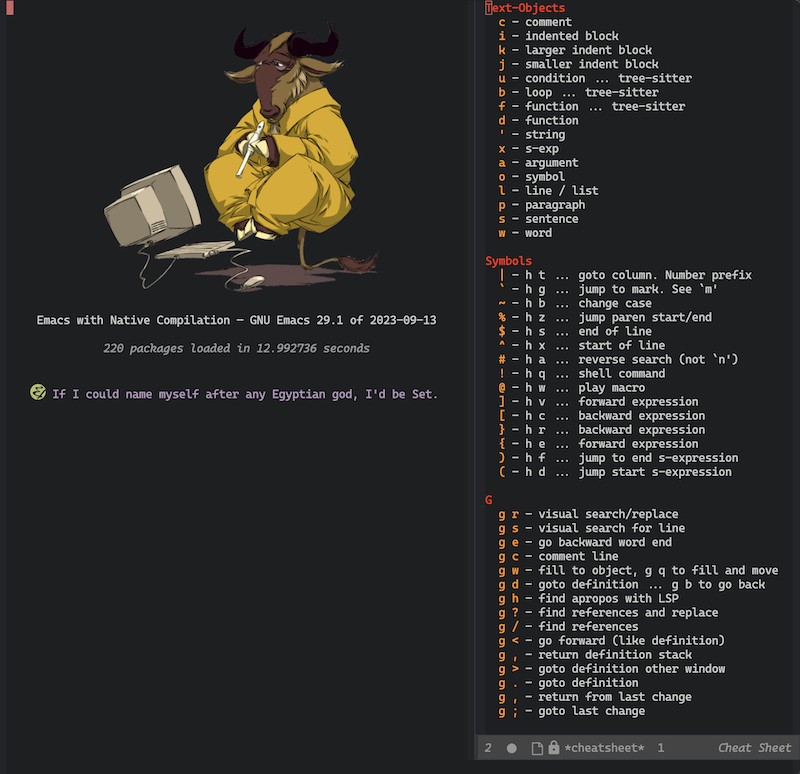My Emacs Configuration
Introduction
I’ve crafted my Emacs configuration, I cheekily call hamacs, in a literate programming model, heavily inspired by my recent journey into Henrik Lissner’s Doom Emacs and Spacemacs. While I used both extensively, I decided I would roll my own as Emacs people like myself, tend to be control freaks (at least a little bit).
The advantage to rolling yer own is I tend to use what I add, leading to less bloat. In reality, this is more fun.
Using literate programming for my Emacs configuration gives me an easy way to share my code. Feel free to steal whatever you find interesting, as sharing makes our community great. Notice that functions and features I have written begin with ha-, but everything else is either stock Emacs or a package I download using straight (see bootstrap for the details) and configure with use-package (see either this introduction or this wiki page for those details)… meaning most blocks of code should work on its own.
I’ve separated my configuration into chapters around particular subjects, applications and programming languages. This feature allows you, dear reader, to jump our to items of interest, but allows me to selectively load individual chapters. For instance, if I’m not doing much with Ruby at work, I can remove that chapter from the list in my bootstrap. I also don’t load my UI configuration when I am using the Terminal (doesn’t happen much, actually).
Hit me up with questions on Mastodon: @howard@pdx.social.
If you want to try the entire process, after installing Emacs (see my instructions for both MacOS and Linux), clone this repo with:
git clone https://github.com/howardabrams/hamacs
And then, run:
./initialize
To create ~/.emacs.d/init.el which starts the process loading the files. Here’s how my Emacs looks when it starts:

Core Configuration
- Bootstrap
- configures
straightand loads basic libraries the rest of the code depends on. It then loads the following files in order. - Configuration
- contains most of my configuration, setting up my sequence key menus, evil, etc.
- Evilness
- configuration for using VI, er,
vimkeybindings in Emacs. - Leader
- using the
SPCto kick off a hierarchical order of functions. - GUI Display
- sets up the visual aspects of an Emacs GUI, including font specification and my theme.
- Dashboard
- sets up initial window layout of the
mainproject with a dashboard. - Data
- functions for dealing with a buffer-full of data.
Org Mode Configuration
- Initial Org Configuration
- configures the basics for org-mode formatted files. Specific features come from their own files.
- Word Processing
- attempts to make Org files visually look like a word processor, including turning off the colors for headers, and instead increasing their size.
- Literate Programming
- functions to support literate programming techniques. I use this with my Emacs configuration.
- Clipboard
- automatically converting HTML from a clipboard into Org-formatted content.
- Journaling
- for writing journal entries and tasks.
- Publishing
- code for publishing my website, www.howardism.org.
- Sprint Notes
- functions for working with the my Org-focused sprint file.
- Agendas
- attempts to “supe-up” my task list.
- Capturing Notes
- my engineering notebook.
Terminal Configuration
If you know me, I appreciate the light-weight nature of Eshell (see this talk at EmacsConf 2022), but Eshell doesn’t work that well with some of my remote work.
- Eshell
- customization and enhancement to the Emacs shell.
- Remote Access
- my interface to systems using SSH and Vterm.
Programming Configuration
While I’m a language polyglot, I often focus on one or two languages at a time, but continue to keep my configuration for those languages around. I’m attempting to convert over to LSP (with varying degrees of success).
- General Programming
- configuration for all programming languages, or at least, the simple ones.
- Emacs Lisp
- additions to Emacs Lisp programming.
- Python
- configuration for working with Python and LSP.
- Scheme
- configuration for Guile and Racket.
- Clojure
- configuration for Clojure.
- Ruby
- configuration for Ruby.
Miscellanea
- Applications
- optional applications, like Twitter and Telegram.
- reading email using
notmuchin a Hey fashion. - RSS Reader
- configuration of
elfeedas well as my RSS feeds. - IRC
- connection to IRC servers using rcirc and bitlbee.
- Passwords
- code for generating passwords.
Summary
The elisp directory contains non-literate code.
Other functions and files come from essays written on my blog. To help with this synchronization, I created a support/final-initialize.el file, but that shouldn’t be too interesting to others.
🤓